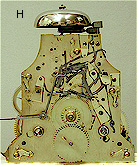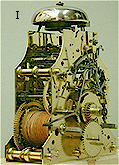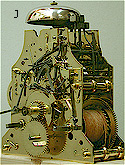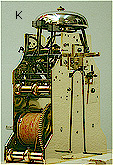|
TOMPION no.145.
A true Dutch striking English clock.

By:
Melgert Spaander.
Table of contents:
Description.
Dutch
striking.
Striking
parts.
Strike
No Strike.
Reconstruction
of the pull repeat.
Bolt & Shutter
maintaining power.
Case.
Observations.
Postscript.
Acknowledgments.
 INTRODUCTION
INTRODUCTION
At the
Drents
Museum
in Assen (The Netherlands) one can find a modest but distinguished longcase clock among many fine examples of Dutch furniture. After
closer observation the dial of this clock appears to bear not a Dutch
name but the signature: Tho=Tompion Londini Fecit.
Immediately the question arises as to how this work of art, made by
this London clockmaker of repute, came to be in the eastern province
of Drenthe? Peter Schoonewille, the Drents Museum’s curator, has
explained that many years ago this clock was bequeathed to the museum
by the old aristocratic family de Vos van Steenwijk, together with its
family archive. It was said that the clock had been in the family
estate for many years. The importance of the clock among the Museum’s
collections was made clearer following a visit by J.H. Leopold of the
British Museum who was able to examine it and underline its special
qualities.
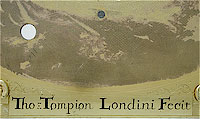
Fig. 1a (click to enlarge)
The dial signature on Tompion's No 145.
The decision was taken to restore the case and following this attention
was paid to the movement in order that it could run safely. The
movement appears to be of a month’s duration and has a complicated
striking mechanism, which is fully recognizable as a Thomas Tompion
design. Although the clock was functional, the many empty holes in the plates suggested that several parts were missing. A detailed
examination to determine its original construction was carried out and
documented. Finally, with the help of Jeremy Evans at the British
Museum we had the opportunity to compare this clock in detail with all
the Tompion clocks he has documented extensively throughout the years.
As a result of this work the clock has given away many of its secrets
and made it possible for the striking mechanism, the complicated
pull-repeat and the bolt & shutter maintaining power to be
reconstructed at some future date. In the mean time, the restored clock
can be admired at the Drents Museum in Assen in expectation of its
possible reconstruction. The clock has also been on display in the
recent Huygens Legacy Exhibition at Palace 'Het Loo', exhibit No.76.
 ) )
 DESCRIPTION
DESCRIPTION
The signature on the
clock ‘Tho=Tompion Londini Fecit’ is engraved on the base of the dial (Fig. 1a)
and the number 145 is stamped on the left side of the trunk door (Fig.
1b) and also on the base of the back plate (Fig. 1c). There are also
the initials VH scratched on the back of the dial components in
several places (Figs 1d&e).
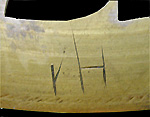

Fig. 1d & 1e. (click to enlarge)
The
initials VH engraved on the back of the
date ring (top) and the seconds chapter ring.
The clock appears to have been made within
the period 1685-1690. The fire-gilt 11 in. square dial (Fig. 1f ) has
four fire-gilt cherub spandrels and features both wheatear banding
along the borders and engraving between the spandrels. There is a
seconds ring and date aperture and the chapter ring has markers for
half-quarters, quarters, half-hours (Tompion’s favored cross style)
and minutes (numbered every five). The strike/no strike lever is
situated at IX. The blued steel hands are of a design commonly used by
Tompion.

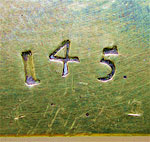
Fig. 1b & 1c (click to enlarge)
The number stamped on the door edge and the lower edge of the back plate.
The case of the clock is of oak, veneered in walnut, with wheatear
banding on all sides and inlaid on the front with colored full floral
marquetry. The originally rising hood, has been altered to a sliding
hood with front door. The hood columns are missing. There are frets in the side windows and a frieze runs around three sides below the top
moldings. Fixing marks on the top of the hood could have been for a
dome or cresting. The plinth has been altered and runs over the
marquetry of the base (Fig. 1g).

Fig. 1g (click to enlarge)
Marquetry case of
Tompion’s No.145.
The month-going movement (Figs
1h,i,j&k) has specially tapered plates, separated by six knobbed
pillars. Holes in the pillars slide over pins in the seat board, the
whole being secured by an adjustable hook on the case back board. The
bolt & shutter maintaining power, activated by a cord inside the trunk,
is all missing. The escapement is recoil anchor and the seconds-beating
pendulum is adjusted by a round nut with Arabic numbers. The movement
has an inside rack for Dutch striking: the hour on a large bell, and
at the half, the coming hour on a small one. Locking is done on the
rack and the snail is on the hour wheel. The striking train is on the
left whilst the hammers are on the right. There is also a passing-strike
mechanism, the first quarter on the large bell and the third quarter
on the small one. Repeating work by pulling a cord on either side of
the trunk, accurate to half an hour, is all missing.
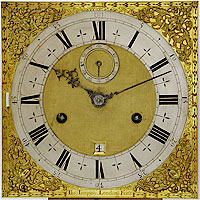
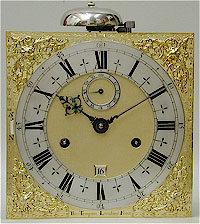
Fig. 1f (click to enlarge)
The dial of Tompion's No 145 before and after
restoration.
The following repair marks have been found
on the movement:
g de groen 17 October 1896
J vd Kolk 14 sept 1900
J Daverschot J Post 16.9.28
P Kluin 3 nov 1930
Schmole 1941 Groningen
 DUTCH STRIKING
DUTCH STRIKING
In the literature
‘Dutch striking’ is mostly defined as striking the hours on a large
bell and at the half-hour on a small bell. Only rarely is it
further
indicated
 )
how many blows
are given at a certain half-hour, and that many Dutch clocks give one
blow at the quarters on either the large or the small bell. In Holland
three kind of striking methods are in use, of which the third type has
two variations. )
how many blows
are given at a certain half-hour, and that many Dutch clocks give one
blow at the quarters on either the large or the small bell. In Holland
three kind of striking methods are in use, of which the third type has
two variations.
Fig. 1h, 1i, 1j & 1k.(click to enlarge)
Four views of the movement The number of the clock can be seen clearly
at the bottom of the back plate
(Fig. 1k).
If literally translated into English, these
Dutch terms would be:
1. ‘Single strike’
 |
At the hour the right number of blows on
a bell. |
 |
At the half-hour 1 blow on the same bell. |
2. ‘Double strike’
 |
At the hour the right number of blows on
a large bell. |
 |
At the half-hour the number of blows of
the coming hour on a small bell. |
3A. ‘Quarter strike’
 |
At the hour the right number of blows on
a large bell. |
 |
At the first quarter 1 blow on the same large
bell. |
 |
At the half-hour the number of blows of
the coming hour on a small bell. |
 |
At the third quarter 1 blow on the same
small bell. |
3B. ‘Quarter strike’
 |
At the hour the right number of blows on
a large bell. |
 |
At the first quarter 1 blow on a small bell. |
 |
At the half-hour the number of blows of
the coming hour on the same small bell. |
 |
At the third quarter 1 blow on the same
large bell. |
In Holland the
clock strikes the coming hour at the half-hour. This reflects the way
that the time is told in the Dutch language. In Holland, at the
half-hour one counts towards the coming hour: ‘half three’ means 14:30.
In England at the half-hour one starts from the passed hour: ‘half
past two’ means 14:30. All together it makes a difference of an hour.
The English version of 3A (not found in Holland) strikes as follows:
3A. ‘Quarter strike’
(English version)
Clock No.145
strikes according Dutch version 3A, so at the half-hour the number of
blows of the coming hour are struck. In a rack-striking clock, the
orientation of the hole in the hour hand boss is essential in this
matter
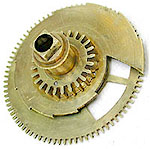
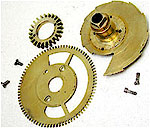

Fig. 2a, 2b & 2c.(click to enlarge)
The snail, the snail disassembled and the hour hand fitting on the hour
pipe
(see following).
 STRIKING PARTS STRIKING PARTS
If, as is the case in
No.145, the pipe of the hour wheel (with its square shoulder for fixing the hour hand) is made in one piece together with the snail, the
number of blows is fixed to the time the hand is showing
(Figs 2a,b&c). Normally the square fixing hole is aligned along the axis of the hand.
With such a ‘normal’ hand, No.145 would have struck the number of blows of the passed hour, at the half-hour, so following the English method
3A.
However, the position of the fixing hole in the hour hand of No.145 is
turned 15º (½ hour anti-clockwise) (Fig. 2d) and because of this the
clock strikes the coming hour at the half-hour in the Dutch way. Its
design does not differ from other hands leaving the workshop of Tompion at the time, except in this detail. It would be interesting to
know if this particular hand (Figs 2e&f ) was made in London or later
in a workshop in Holland.
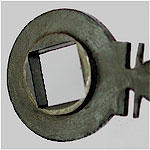
Fig. 2 d (click to enlarge)
Square fixing hole in the hour hand, offset 15° to ensure correct Dutch
striking.
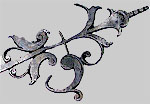
Fig. 2 e (click to enlarge)
Detail of hour hand before repair.

Fig. 2 f (click to enlarge)
Detail of the minute hand.
Of the Tompion clocks we have seen, No.311 at Lyme Park bears the
greatest resemblance to No.145 with its pull repeat and Strike/Silent
on the dial. The hour hand is a ‘normal’ one and indeed it strikes the
English way at the half-hour. The catalogue of clocks at Lyme Park
however indicates that it has Dutch striking. English clocks exported
to the Netherlands up until c.1750, have the hour hand with a round
hole to be fixed on a round shoulder of the hour pipe by a tiny screw
through a little hole in the hand (or steady pin in a small slot). By
making just another little hole (or slot) 1/24 of the circumstance
next to it, the striking system is modified to suit the Dutch market.
Screwing a separate snail on the hour wheel was another way of solving
the problem. With an extra hole in this part, the same adaptation could
also be obtained.
 S(TRIKE) N(O STRIKE) S(TRIKE) N(O STRIKE)
With lever (E) in
position N (Figs 3a,b&c), the clock will be prevented from striking
during normal running. The bent arm of lever (E) turns the horizontal
pivoted pin (Aa) of the lifting piece in such a way, that this pin can
no longer reach the rack hook (B) to release the rack (Figs 3d, e & f ).
Thus the lifting piece (A) rises and drops of every half an hour
without any effect, whilst the striking train is kept available for
repeating.
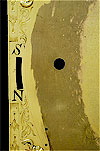
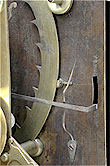
Figs. 3a & 3b (click to enlarge)
a)
Detail of the Strike/No strike slot in the dial.
b)
The Strike/No strike lever behind the dial.
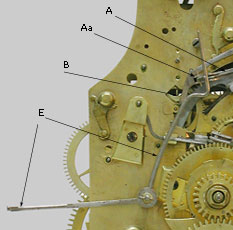
Fig.
3c (click to enlarge)
Deatail of the Strike/No strike system, showing the lever E, the
pivoted pin Aa, and the rack hook B.
end
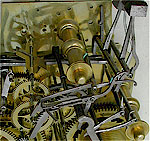
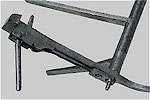
Fig.
3f (click to enlarge)
Lifting piece A with pivoting pin.

End
of this section, click
here to continue.

|
 Back to previous section.
Back to previous section.
 RECONSTRUCTION OF THE PULL
REPEAT
RECONSTRUCTION OF THE PULL
REPEAT
The repeat mechanism is completely missing. By starting with the empty
holes in the plates and studying striking trains of other Tompions,
gradually we were able to reconstruct its unusual operation (Figs
4a,b&c).
If either cord to the left or right side of the case was pulled during
the first half of an hour, the large bell would sound the passed hour
and during the second half the small bell would sound the coming hour.
The multi-function repeat lever (D) was located in the upper left
corner, pivoted in the back plate and a cock (R) screwed on the front
plate. The strong spring (G) screwed on the cock holds this lever in its
upper position. On pulling the cord for repetition, the main arm of
lever (D) comes down to press with pin (d) on the scrolled back end of
the lifting piece (A), resulting in a normal striking procedure as every
half an hour.
However just a few minutes before every half-hour the repeat work is
susceptible to failure as the strike changes over from one bell to the
other or from striking 2 or 3 (for example).
4b
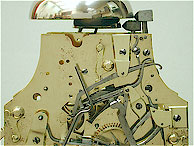
Figs. 4b. (click to enlarge)
Views of the movement showing
the area where the repeat mechanism is missing.
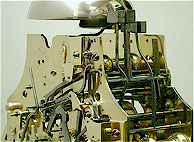
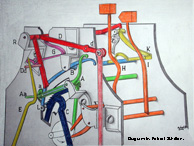
Fig. 4b. (click to enlarge)
Diagrammatic representation of the missing repeat mechanism. Compare with
fig 4a.
If the rack (C) falls on the snail at that very moment, the gathering
pallet could jam on a rack tooth, so blocking the striking train
completely. This problem was effectively solved by Tompion by bringing
lifting piece (A) into use for repetition. A few minutes before the
clock strikes, the lifting piece (A) moves upward, meanwhile blocking
with its hook (Aa) the frontal arm of repeat lever (D). As a consequence
the repeat cord can not be pulled for a short period of minutes. After
the critical transition has passed and lifting piece (A) has dropped
off, the cord is free for repetition again. In addition, by using the
warning, the rack was given enough time to drop properly onto the snail.
4c
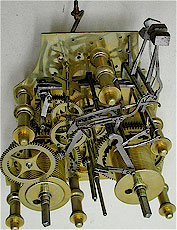
Fig. 4c. (click to enlarge)
View of the movement with the front plate removed. Compare with Fig 4b
for the missing repeat work.
So as to enjoy a good night’s rest, the S/N lever (E) not only silenced
the striking train but the passing strike as well. In position N the tip
of lever (E) moved pin (Dd) on the frontal arm of repeat lever (D)
slightly to the left, so that its other arm between the plates was
holding back the quarter hammers (H&I) by means of an intermediate lever
(K) pivoted in the back plate.
However, to achieve a repeat in position N, activating the lifting piece
(A) is not enough; the scrolled back end of rack hook (B) has to be
pressed by pin (d) on the main arm of lever (D) as well. This is
necessary, because in position N, lever (E) has turned away pin (Aa) in
lifting piece (A), taking away its connection towards rack hook (B) to
unlock the rack (C) and release the striking train.
 BOLT & SHUTTER MAINTAINING
POWER
BOLT & SHUTTER MAINTAINING
POWER
All the holes for the parts needed still exist. It is possible to
restore the mechanism in Tompion style whilst dealing with the lack of
space on the front plate, as found on other clocks made by him.
 CASE
CASE
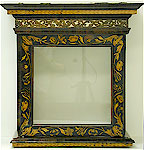
Fig. 5. (click to enlarge)
The hood showing the marquetry.
Traces remaining in the hood (Figs 5a&b) prove that it was made as a
rising hood with a fixed glazed front panel and columns on the corners.
At an early stage it was converted to a hinged door, locked by a key.
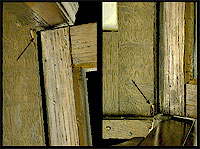

Figs. 5a (click to enlarge)
Traces of the former rising hood and pillars.
Remaining saw marks (Fig. 5c shows one example) and the corresponding
wood veins of separate parts, formerly one piece, are evidence of this
procedure. This whole operation made the sometimes daily operated S/N lever on the dial
accessible without lifting the hood.
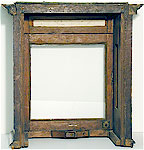
Fig. 5b. (click to enlarge)
Internal view of the hood, showing the cutting of the door
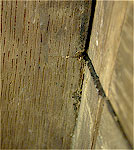
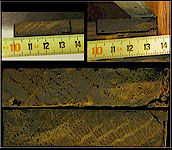
Figs. 5c. (click to enlarge)
Detail of the saw marks made when the hood was cut to make a door, and
the corresponding wood veins of separate parts, formerly one piece.
For securing the hood, a pin fixed at the back of the door enters a hole
in the trunk when closing this door which is then locked by a key. This
assembly (Figs 5d&e) has also been found on other Tompion cases.
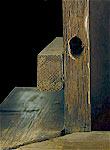
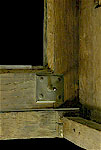
Fig. 5d & 5e. (click to enlarge)
Location pin in door frame and corresponding hole in the case upstand.
In a later period the hood was modified from rising to sliding and
locked by a turn catch (this can be seen in Fig. 5b). However the
remains of a lock with its spring (Fig. 5f ) are witness to the original
rising hood construction. The columns appear to have been removed only
recently. Traces on the top of the hood (Fig. 5g) suggest the former
presence of a dome or carved cresting on three sides.
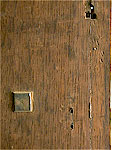
Fig. 5f. (click to enlarge)
Marks left on the back board by the removal of the original catch and
spring for the rising hood.
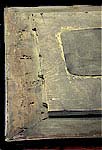
Fig. 5g. (click to enlarge)
Tel-tale marks left on the top of the hood by removal of a cresting
or dome.
Both sides of the trunk have little brass tubes
for guiding the cords via brass pulleys, mounted on the back the right
of the upper molding, towards the repeat mechanism (Figs 5h&i).
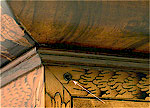
Fig. 5h. (click to enlarge)
hole for brass guide tube for repeat cord, in the right hand side
of the case.
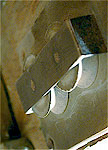
The
original feet are missing and recently skirting has been applied which
covers the bottom of the marquetry panel.
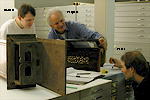
Fig. 55. (click to enlarge)
Melgert Spaander, Robert Schilten and curator Peter Schoonewille studying
the case at the Drents Museum.
 OBSERVATIONS
OBSERVATIONS
Apparently Tompion’s clocks
No 131, 311 & 387 contain almost identical
constructions of the repeat work designed for No.145. The movement of
No.311 at Lyme Park (Fig. 6a) is also executed with the same specially
shaped plates (Fig. 6b).

Fig. 6a. (click to enlarge)
Tompion's no. 311 at Lyme park, National Trust.
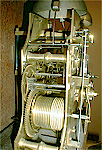
Fig. 6b. (click to enlarge)
View of the movement of Tompion's no. 311, with similar shaped plates.
Though Tompion movements may have strong resemblances, they often
diverge in serial number. In Jeremy Evans’ view this indicates that
Tompion used to make several standard movements and dials which he kept
‘on the shelf’ in his workshop ready for finishing when required. The
countless conversions and adaptations we found in No.145, verifiably
made at a very early stage, confirm Jeremy’s ideas in this matter.
When William III
became King of England in 1689, Tompion found him to be a great lover
of technical instruments and he became an important client. The King
ordered the most complicated movements from Tompion in precious
eye-catching cases to embellish his sumptuous palaces. William also gave
away clocks or watches as gifts to many of his international relations
and acquaintances, so objects signed by Tompion appear on the scene
all over the world. Being Stadholder of Holland, William III acted as
a mediator for Tompion and gave him opportunities to increase his
export activities to the Netherlands and other parts of continental
Europe.
On 6th May 1697 Tompion gained a passport for
traveling through the
Netherlands together with a Dr Pragest.
 )
His introduction to wealthy Dutch families may well have resulted in a
number of important orders. )
His introduction to wealthy Dutch families may well have resulted in a
number of important orders.
According to its dating of 1685-1690, based on its number and
appearance, No.145 would have been too old to be made specifically for
the visit of 1697. This implies that either Tompion exported this clock
in an earlier period, or that he adapted an older clock especially for
Dutch clientele, to be sold during his voyage.
The noble family de Vos van Steenwijk was the last owner of No.145, but
they may have also been the first. The family archive possibly contains
relevant details regarding this subject. The lay out of the striking
parts shows at least, that No.145 originally was made to be used in
England.
In both Holland and England was a demand for clocks fully striking at the hour,
as well as at the half-hour on different bells. Essentially most English
clocks with so called Dutch striking, have nothing to do with Holland at
all, except the exported ones of course. It may well be that this
striking method formerly had its own name in England, and fell into
disuse together with the device itself. It would be interesting to know
if the expression ‘Dutch striking’ was used in the seventeenth century,
or originated as late as the twentieth century. Generally speaking,
grande sonnerie is not practiced in clocks made in Holland, probably
because this way of striking would only lead to confusion in determining
the time by sound.
This investigation of Tompion’s No.145 throws extra light on the
practices of clockmakers on both sides of the English Channel during the
period when William III was at the same time Stadholder of Holland and
King of England.
 POSTSCRIPT
POSTSCRIPT
The reconstruction of the missing mechanism in Tompion’s No.145 has yet
to be carried out. It is important that any future work is reversible, and
the original are not altered.
 ACKNOWLEDGEMENTS
ACKNOWLEDGEMENTS
I would like to thank Robert Schilten, Jaap Boonstra and Michael
Applebee for their much appreciated assistance. Also, I am indebted to
Peter Schoonewille of the
Drents
Museum in Assen, Clair Bissell of Lyme
Park (National Trust), and J.H. Leopold and Jeremy Evans of the British
Museum. It would have been difficult to complete this work without their
help.
Zutphen, The Netherlands, Oct. 2004.

Notes.
1. Hans van
den Ende, Dr Frits van Kersen, Maria F. van Kersen-Halbertsma, Dr John
C. Taylor and Neil R. Taylor, Huygens’ Legacy, catalogue of an
exhibition held at Paleis Het Loo, (Castletown, Isle of Man: Fromanteel
Ltd, 2004), pp.218-219. (back
to text)
2. See, for example, R.W.
Symonds, THOMAS TOMPION his life and work, (B.T.Batsford, 1951), p.115
and Tom
Robinson, The Longcase Clock, (Woodbridge: Antique Collectors Club,
1981), p.132. (back
to text)
3. Symonds, op. cit.,
p.41.
(back
to text)
 back to text.
back to text.
|









